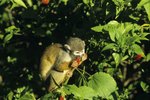
The sugar glider (Petaurus breviceps) is a wee, omnivorous marsupial native to Australia, Papua New Guinea and Indonesia. These bluish-gray possums are aptly named for their gliding abilities -- not to mention their penchant for consuming "sugary" things -- think tree sap. Like the vast majority of animals on this planet, sugar gliders are also subject to predation.
Details on the Sugar Glider
Sugar gliders are relatively abundant within their natural geographic scope. These companionable tree leapers live in a variety of different forest habitats, including degraded and primary woodlands. As long as sugar gliders are capable of finding sufficient sustenance in a specific forest, they will probably remain there. Apart from tree sap, the general sugar glider diet consists of acacia gum, nectar from flowers, pollen, nuts, bugs, bug larvae and some tiny mammals such as mice. As for sources of tree sap, they gravitate to the eucalyptus tree. Sugar gliders usually weigh somewhere in the range of 114 and 171 grams, according to Animal Bytes of SeaWorld.
Predators of the Sugar Glider
A wide array of different animals commonly feed on sugar gliders. These predators are snakes, feral cats, quolls, kookaburras, lace monitor lizards, owls, mulgaras, foxes and antechinuses. Many of these predators -- such as the antechinus, which is a prickly textured, mouse-like marsupial -- exist solely in Australia and nearby lands.
Gliding to Avoid Predation
It is very rare to see a sugar glider on the ground. These arboreal animals are usually up in trees. Gliding not only is an effective means of sugar glider transportation, but also perhaps a way of remaining out of the reach of dangerous predators, according to Tasmania's Department of Primary Industries.
Predators and Sugar Glider Early Death
Many sugar gliders do not make it past the first year of their lives, as they are very vulnerable to predators when they are young and small. If they can make it past the threats of predators during the first years of their lives, however, they can sometimes survive to 14 years old, indicates Animal Diversity Web of the University of Michigan.
References
- SeaWorld Animal Bytes: Sugar Glider
- Wildlife Preservation Society of Queensland: Sugar Glider
- IUCN Red List: Petaurus breviceps
- University of Michigan Animal Diversity Web: Petaurus breviceps
- Discover Wildlife: Sugar Glider
- Life in the Suburbs: Petaurus breviceps
- Tasmania Department of Primary Industries: Sugar Glider
Photo Credits
-
Jupiterimages/Photos.com/Getty Images




